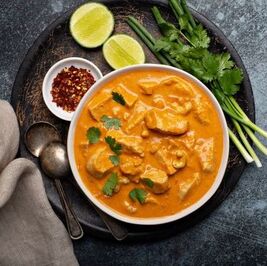…from the California Kitchen How you doin’? There’s no business like food business or so it plays on Broadway. Maybe they’re referring to show biz, but I’ve done both businesses and food is a lot more fun. One of the things I really love is that when you travel to a foreign and somewhat exotic country you can be immersed into the indigenous foods of the region, including taking cooking classes. In Thailand, Joan and I took cooking classes at the Bangkok Oriental Hotel to learn new Thai cooking techniques. You may have thought that curry dishes were just found in India, but that’s not so. The first evidence of curry was recently discovered in India, dating back to around 2500 B.C., but curries can be found in many different countries. The word "curry" is actually an Anglicized version of the Tamil word "kari." As settlers and traders came to India from as far away as Japan, China, Portugal, Spain, and France, they disseminated recipes for curry throughout southeast Asia, each with a different national twist. There are many different Thai curry techniques. Thai country curry is boiled with a little water to open the spicy flavors; it is a lighter, soupier curry. The city curry is fried with a little oil to bring out the full flavor of the curry spices and produce a thicker curry, but it’s not that simple. Thai people refer to dishes that are known as "Thai Curries" in the Western world as kaeng. The first Thai dictionary from 1873 CE (2416 in the Thai Buddhist calendar) defines kaeng as a watery dish to be eaten with rice and utilizing shrimp paste, onions or shallots, chilies and garlic as essential ingredients. Coconut milk was not included in this definition and many Thai curries, such as kaeng som and kaeng pa, do not feature it. Curries in Lanna (northern Thai) cuisine, with only a few exceptions, do not use coconut milk because coconut palms do not grow well there, if at all, in the climate of the Thai highlands. The spiciness of Thai curries depends on the amount and kind of chili used in the making of the paste. Even within one type of curry the spiciness can differ widely. Although "kaeng" is defined as being watery, the thickness of the sauce can vary considerably by the preparations from broth-like to that of a thick stew. It can even be a completely dry dish. Dry curries, dishes which are stir-fried with a curry paste, are phat phrik khing and khua khling. Kaeng som and keang pa are the more broth-like curries. Matsaman and kaeng khua resemble stews. Ho mok (a fish curry "soufflé"), kaeng kradang (curry aspic from northern Thailand) and noodle dishes such as khanom chin nam ngiao are also seen as Thai curry dishes as they all use curry pastes in their preparation. Most curries are eaten in combination with long-grained jasmine rice in central and southern Thailand; with sticky rice in northern and northeastern Thailand; and with noodles such as khanom chin (fermented rice noodles). Certain curries can also be eaten with roti, the Thai version of the Indian-style fried flat bread from Malaysia called roti canai. Curries in Thailand mainly differ from the curries in Indian cuisine in their use of ingredients such as herbs and aromatic leaves over a mix of spices. My Instant Pot Thai Red Curry chicken is a quick and delicious version with chicken, onions, and bell peppers. Enjoy it hot over jasmine rice. If you like, add Thai basil leaves for additional brightness. Prep time: 10 minutes Cook time: 15 minutes Natural release time: 10-20 minutes Yield: 5 servings Ingredients 1 tablespoon cooking oil 2 tablespoons red curry paste, or more to taste 1-1/2 pounds thin, boneless, skinless chicken breasts, cut into 1-inch strips 1 (14 ounce) can unsweetened light coconut milk 1 tablespoon Thai fish sauce, or more to taste 1 tablespoon palm sugar 1 cup sliced yellow onion 1 cup sliced red bell pepper 1 cup sliced yellow bell pepper 1 cup sliced orange bell pepper jasmine rice for serving Thai basil for garnish Directions
ChefSecrets: If you prefer a thicker curry, add only a half can of coconut milk. If you are using thicker chicken breasts, thighs or duck legs, increase cooking time to 4 to 6 minutes. Covid-19 Quip of the Day: “I’ve been shopping more on the internet than ever before. The hardest part of the transaction is getting my fat butt off the couch to get a credit card to pay for it.” ------------------------------------------- Do you have a question or comment? Do you want to share a favorite recipe or pictures with our readers? Send your thoughts to [email protected]. All recipes and cooking tips are posted on our website https://www.perspectives-la.com/covid-19-survival-guide. We have added a new search feature to make it easier to navigate through our blogs. ------------------------------------------- To you and everyone dear to you, be strong and positive, stay well and safe and be kind to others. If you have a little extra in your pockets to share with others at this difficult time, please consider donating to Feeding America. Thanks for reading. #Entrees #InstantPot #ThaiCurry #Chicken #OrientalBangkok #Red Curry #QuarantineKitchen #Covid19 #FeedingAmerica #PerspectivesTheConsultingGroup ©Perspectives/The Consulting Group, Inc., 2021
0 Comments
Your comment will be posted after it is approved.
Leave a Reply. |
For over 4 decades collaboration and vision have been the cornerstones of our approach to developing innovative solutions. We fuel innovation, uncover opportunities, discover trends and embrace sustainability, turning imaginative ideas into profitable realities. Categories
All
Archives
July 2024
|
www.perspectives-la.com
Copyright © 2021 Perspectives/The Consulting Group, LLC | Henderson, NV 89052 | 310-477-8877
Copyright © 2021 Perspectives/The Consulting Group, LLC | Henderson, NV 89052 | 310-477-8877


 RSS Feed
RSS Feed